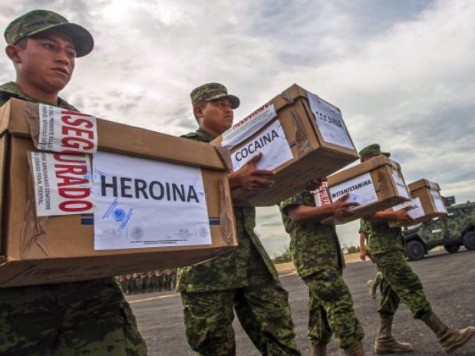
The U.S. Drug Enforcement Agency (DEA) has released their 2013 National Drug Threat Assessment Summary and revealed that both heroin and meth trafficking are increasing across the U.S./Mexico border–and that Mexican cartels, which the DEA refers to as Transnational Criminal Organizations (TCOs), are expanding into the far reaches of the United States.
“The availability of heroin continued to increase in 2012, likely due to high levels of heroin production in Mexico and Mexican traffickers expanding into white powder heroin markets in the eastern and midwest United States,” said the report regarding heroin.
“Availability indicators reflect that the supply of Mexican methamphetamine is increasing in the United States. Price and purity data and increased methamphetamine flow across the Southwest Border indicate rising domestic availability, most of which is the result of high levels of methamphetamine production in Mexico,” said the report regarding methamphetamine.
The DEA report avoided using the term cartel to describe Mexican cartels, opting instead for the term “TCOs” or “Transnational Criminal Organizations.” However, in describing the TCOs, they wrote of the conflict between them for trade and smuggling routes in Northern Mexico, thus revealing the term TCOs is used by the DEA to include the description of groups that are know as “Mexican cartels” to the general public.
Another concerning aspect of the report pertained to the continuing decrease of cocaine availability in the U.S. The DEA stated: “The trend of lower cocaine availability in the United States that began in 2007 continued in 2012. Moreover, reporting from several metropolitan areas including Chicago, Houston, St. Louis, Phoenix, and Baltimore indicated sporadic interruptions in cocaine availability in the spring of 2012.”
Though the decrease in cocaine availability is surely good news to families of those suffering with cocaine addictions, the assessment–when coupled with the data presented in a 2012 report from the United Nations Office on Drugs and Crime (UNODC)–indicates human trafficking, sex trafficking, and other heinous crimes may increase as a result of Mexican cartels attempting to replace their cocaine profits.
The UN report stated: “If cocaine flows abate, they will seek revenues from other forms of acquisitive crime, such as extortion, which may cause violence levels to increase.” The report also stated: “The Zetas, the Maras [groups like MS-13], and other territorial groups appear to be involved in migrant smuggling, human trafficking, and the firearms trade. This involvement may increase if cocaine revenues decline.”
Read the entire DEA 2013 National Drug Threat Assessment:

COMMENTS
Please let us know if you're having issues with commenting.